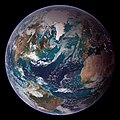Fichier:Blue Marble Western Hemisphere.jpg

Taille de cet aperçu : 600 × 600 pixels. Autres résolutions : 240 × 240 pixels | 480 × 480 pixels | 768 × 768 pixels | 1 024 × 1 024 pixels | 2 048 × 2 048 pixels | 3 718 × 3 718 pixels.
Fichier d’origine (3 718 × 3 718 pixels, taille du fichier : 2,65 Mio, type MIME : image/jpeg)
Historique du fichier
Cliquer sur une date et heure pour voir le fichier tel qu'il était à ce moment-là.
| Date et heure | Vignette | Dimensions | Utilisateur | Commentaire | |
|---|---|---|---|---|---|
| actuel | 5 mars 2013 à 13:59 |  | 3 718 × 3 718 (2,65 Mio) | Szczureq | User created page with UploadWizard |
Utilisation du fichier
Les 6 pages suivantes utilisent ce fichier :
Usage global du fichier
Les autres wikis suivants utilisent ce fichier :
- Utilisation sur alt.wikipedia.org
- Utilisation sur av.wikipedia.org
- Utilisation sur bn.wikipedia.org
- Utilisation sur ca.wikipedia.org
- Utilisation sur ckb.wikipedia.org
- Utilisation sur cv.wikipedia.org
- Utilisation sur da.wikipedia.org
- Utilisation sur el.wikipedia.org
- Utilisation sur en.wikipedia.org
- Ecological footprint
- User:P3Y229/sandbox
- Wikipedia:Meetup/NYC/AfroCrowd/Home
- Wikipedia:Wikipedia Signpost/2018-10-28/Gallery
- Wikipedia:Wikipedia Signpost/Single/2018-10-28
- User:Lngnbchr/TWA/Earth/2
- User:Saoirse mck/TWA/Earth/2
- User:Northamerica1000/Topics
- User:Nikola Tesla edit/TWA/Earth/2
- User:SDL87/TWA/Earth/2
- User:Mpurcell1/TWA/Earth/2
- User:Mpbrooke/TWA/Earth/2
- User:Tlonedyr
- User:JD Cornbread/TWA/Earth/2
- Utilisation sur en.wikibooks.org
- Utilisation sur en.wikiquote.org
- Utilisation sur en.wiktionary.org
- Utilisation sur es.wikipedia.org
- Utilisation sur eu.wikipedia.org
- Utilisation sur fa.wikipedia.org
- Utilisation sur fi.wikipedia.org
- Utilisation sur he.wikipedia.org
- Utilisation sur hu.wikipedia.org
- Utilisation sur hy.wikipedia.org
- Utilisation sur id.wikipedia.org
- Utilisation sur it.wiktionary.org
- Utilisation sur ja.wikipedia.org
- Utilisation sur kk.wikipedia.org
- Utilisation sur ko.wikipedia.org
- Utilisation sur lez.wikipedia.org
- Utilisation sur lt.wikipedia.org
- Utilisation sur mk.wikipedia.org
- Utilisation sur mnw.wiktionary.org
Voir davantage sur l’utilisation globale de ce fichier.



